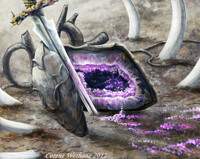
Developing the concept further. Some day I'm just going to have to make up a field guide of random critters.
"Juveniles of the species are lighter in color, ranging from almost white to pale brown. Each molting the young will change their coloring to match their current environment. Once the new exoskeleton hardens, this new color become permanent until the next molting cycle. The young turn dark and join the adult swarm after 2 years. At 3 years of age they start showing their brightly colored patterns and are able to reproduce."
"Raines Astrates: (The Iridescent Swarm)
A carnivorous arachnid of the high desert. Adults live in roaming swarms of several thousand individuals. Larva and young are solitary and will prey on each other when the opportunity arises.
Able to see ultraviolet light spectrum.
Localized paralytic is initially painful but quickly numbs the area to allow the raines to feed: highly visible under UV light.
Can expel air through vents on thorax, which vibrate in a high-pitched “purr”."
"Juveniles of the species are lighter in color, ranging from almost white to pale brown. Each molting the young will change their coloring to match their current environment. Once the new exoskeleton hardens, this new color become permanent until the next molting cycle. The young turn dark and join the adult swarm after 2 years. At 3 years of age they start showing their brightly colored patterns and are able to reproduce."
"Raines Astrates: (The Iridescent Swarm)
A carnivorous arachnid of the high desert. Adults live in roaming swarms of several thousand individuals. Larva and young are solitary and will prey on each other when the opportunity arises.
Able to see ultraviolet light spectrum.
Localized paralytic is initially painful but quickly numbs the area to allow the raines to feed: highly visible under UV light.
Can expel air through vents on thorax, which vibrate in a high-pitched “purr”."
Category All / Fantasy
Species Arachnid
Size 1224 x 635px
File Size 171 kB

 FA+
FA+










Comments